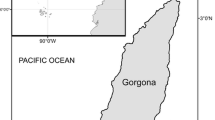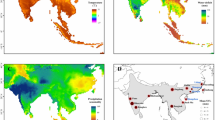Abstract
From 1976 onward, molting brant geese (Branta bernicla) within the Teshekpuk Lake Special Area, Alaska, shifted from inland, freshwater lakes toward coastal wetlands. Two hypotheses explained this redistribution: (1) ecological change: redistribution of molting brant reflects improvements in coastal foraging habitats, which have undergone a succession toward salt-tolerant plants due to increased coastal erosion and saltwater intrusion as induced by climate change or (2) interspecific competition: greater white-fronted geese (Anser albifrons) populations increased 12-fold at inland lakes, limiting food availability and forcing brant into coastal habitats. Both hypotheses presume that brant redistributions were driven by food availability; thus, body mass dynamics may provide insight into the relevance of these hypotheses. We compared body mass dynamics of molting brant across decades (1978, 1987–1992, 2005–2007) and, during 2005–2007, across habitats (coastal vs. inland). Brant lost body mass during molt in all three decades. At inland habitats, rates of mass loss progressively decreased by decade despite the increased number of greater white-fronted geese. These results do not support an interspecific competition hypothesis, instead suggesting that ecological change enhanced foraging habitats for brant. During 2005–2007, rates of mass loss did not vary by habitat. Thus, while habitats have improved from earlier decades, our results cannot distinguish between ecological changes at inland versus coastal habitats. However, we speculate that coastal forage quality has improved beyond that of inland habitats and that the body mass benefits of these higher quality foods are offset by the disproportionate number of brant now molting coastally.







Similar content being viewed by others
References
Alatalo RV, Eriksson D, Gustafsson L, Larsson K (1987) Exploitation competition influences the use of foraging sites by tits: experimental evidence. Ecology 68:284–290
Ankney CD (1979) Does the wing molt cause nutritional stress in lesser snow geese? Auk 96:68–72
Ankney CD (1984) Nutrient reserve dynamics of breeding and molting brant. Auk 101:361–370
Bautista LM, Alonso JC, Alonso JA (1995) A field test of ideal free distribution in flock-feeding common cranes. J Anim Ecol 64:747–757
Black JM, Deerenberg C, Owen M (1991) Foraging behaviour and site selection of barnacle geese Branta leucopsis in a traditional and newly colonised spring staging habitat. Ardea 79:349–358
Bollinger KS, Derksen DV (1996) Demographic characteristics of molting black brant near Teshekpuk Lake, Alaska. J Field Ornithol 67:141–158
Brown RE, Saunders DK (1998) Regulated changes in body mass and muscle mass in molting blue-winged teal for an early return to flight. Can J Zool 76:26–32
Burnham KP, Anderson DR (2002) Model selection and multi-model inference: a practical information-theoretic approach. Springer, New York
Creswell W (1997) Interference competition at low competitor densities in blackbirds Turdus merula. J Anim Ecol 66:461–471
Derksen DV, Weller MW, Eldridge WD (1979) Distributional ecology of geese molting near Teshekpuk Lake, National Petroleum Reserve-Alaska. In: Jarvis RL, Bartonek JC (eds) Management and biology of pacific flyway geese. Oregon State University Bookstores, Corvallis, pp 189–207
Derksen DV, Eldridge WD, Weller MW (1982) Habitat ecology of Pacific black brant and other geese moulting near Teshekpuk Lake, Alaska. Wildfowl 33:39–57
Dolnik RD, Gavrilov VM (1979) Bioenergetics of molt in the chaffinch (Fringilla coelebs). Auk 96:253–264
Flint PL, Mallek EJ, King RJ, Schmutz JA, Bollinger KS, Derksen DV (2008) Changes in abundance and spatial distribution of geese molting near Teshekpuk Lake, Alaska: interspecific competition or ecological change? Pol Biol 31:549–556
Fox AD, Kahlert J (2000) Do moulting greylag geese Anser anser forage in proximity to water in response to food availability and/or quality? Bird Study 47:266–274
Fox AD, Kahlert J (2005) Changes in body mass and organ size during wing moult in non-breeding greylag geese Anser anser. J Avian Biol 36:538–548
Fox AD, Kahlert J, Walsh AJ, Stroud DA, Mitchell C, Kristiansen JN, Hansen EB (1998) Patterns of body mass change during moult in three different goose populations. Wildfowl 49:45–56
Guillemette M, Pelletier D, Grandbois J, Butler PJ (2007) Flightlessness and the energetic cost of wing molt in a large sea duck. Ecology 88:2936–2945
Harrison XA, Blount JD, Inger R, Norris DR, Bearhop S (2011) Carry-over effects as drivers of fitness differences in animals. J Anim Ecol 80:4–18
Heise CD, Moore FR (2003) Age-related differences in foraging efficiency, molt, and fat deposition of gray catbirds prior to autumn migration. Condor 105:496–504
Heitmeyer ME (1985) Protein costs of the prebasic molt of female mallards. Condor 90:263–266
Hohman WL, Ankney CD, Gordon DH (1992) Ecology and management of postbreeding waterfowl. In: Batt DJ, Afton AD, Anderson MG, Ankney CD, Johnson DH, Kadlec JA, Krapu GL (eds) Ecology and management of breeding waterfowl. University of Minnesota Press, Minneapolis, pp 128–189
Hudson JMG, Henry GHR (2009) Increased plant biomass in a high arctic heath community from 1981 to 2008. Ecology 90:2657–2663
Inger R, Harrison XA, Ruston GD, Newton J, Colhoun K, Gudmundsson GA, McElwaine G, Pickford M, Hodgson D, Bearhop S (2010) Carry-over effects reveal reproductive costs in a long-distance migrant. J Anim Ecol 79:974–982
Jenni L, Winkler R (1994) Moult and ageing of European passerines. Academic Press, London
Jones BM, Hinkel KM, Arp CD, Eisner WR (2008) Modern erosion rates and loss of coastal features and sites, Beaufort Sea coastline, Alaska. Arctic 61:361–372
Kacelnik A, Krebs JR, Bernstein C (1992) The ideal free distribution and predator-prey populations. Trends Ecol Evol 7:50–55
Keeling CD, Chin JFS, Whorf TP (1996) Increased activity of northern vegetation inferred from atmospheric CO2 measurements. Nature 382:146–149
Lewis TL, Flint PL, Schmutz JA, Derksen DV (2010) Pre-moult patterns of habitat use and moult site selection by brent geese Branta bernicla nigricans: individuals prospect for moult sites. Ibis 152:556–568
Lewis TL, Flint PL, Schmutz JA, Derksen DV (2011) Fine scale movements and habitat use of black brant during the flightless wing molt in Arctic Alaska. Waterbirds: in press
Lind J, Jakobsson S (2001) Body building and concurrent mass loss: flight adaptations in tree sparrows. Proc R Soc B 268:1915–1919
Mallek EJ (2007) Teshekpuk Lake area molting goose survey 2007. US Fish Wildlife Service, Fairbanks
Markon CJ, Derksen DV (1994) Identification of tundra land cover near Teshekpuk Lake, Alaska using SPOT satellite data. Arctic 47:222–231
Mars JC, Houseknecht DW (2007) Quantitative remote sensing study indicates doubling of coastal erosion rate in past 50 years along a segment of the Arctic coast of Alaska. Geology 35:583–586
Owen M, Ogilvie MA (1979) Wing molt and weights of barnacle geese in Spitsbergen. Condor 81:42–52
Panek M, Majewski P (1990) Remex growth and body mass of mallards during wing molt. Auk 107:255–259
Park T (1962) Beetles, competition, and populations. Science 138:1369–1375
Parmesan C, Yohe G (2003) A globally coherent fingerprint of climate change impacts across natural systems. Nature 421:37–42
Person BT, Herzog MP, Ruess RW, Sedinger JS, Anthony RM, Babcock CA (2003) Feedback dynamics of grazing lawns: coupling vegetation change with animal growth. Oecologia 135:583–592
Portugal SJ, Green JA, Butler PJ (2007) Annual changes in body mass and resting metabolism in captive barnacle geese (Branta leucopsis): the importance of wing moult. J Exp Biol 210:1391–1397
Reed A, Ward DH, Derksen DV, Sedinger JS (1998) Brant (Branta bernicla). In: Poole A, Gill F (eds) The birds of North America, no 337. Academy of Natural Sciences, Philadelphia
Root TL, Price JT, Hall KR, Schneiders SH, Rosenzweig CR, Pounds JA (2003) Fingerprints of global warming on wild animals and plants. Nature 42:57–60
Schoener TW (1983) Field experiments on interspecific competition. Am Nat 122:240–285
Sedinger JS, Herzog MP, Person BT, Kirk MT, Obritchkewitch T, Martin PP, Stickney AA (2001) Large-scale variation in growth of black brant goslings related to food availability. Auk 118:1088–1095
Stahl J, Tolsma PH, Loonen MJJE, Drent RH (2001) Subordinates explore but dominants profit: resource competition in high Arctic barnacle goose flocks. Anim Behav 61:257–264
Swaddle JP, Williams EV, Rayner JMV (1999) The effect of simulated flight feather moult on escape take-off performance in starlings. J Avian Biol 30:351–358
Taylor EJ (1993) Molt and bioenergetics of Pacific black brant (Branta bernicla nigricans) on the Arctic Coastal Plain, Alaska. Dissertation, Texas A&M University
Taylor EJ (1995) Molt of black brant (Branta bernicla nigricans) on the Arctic Coastal Plain, Alaska. Auk 112:904–919
van de Wetering D, Cooke F (2000) Body weight and feather growth of male Barrow’s goldeneye during wing molt. Condor 102:228–231
Walther G, Post E, Convey P, Menzels A, Parmesan C, Beebee TJC, Fromentin J, Hoegh-Guldberg O, Bairlein F (2002) Ecological responses to recent climate change. Nature 416:389–395
Ward DH, Reed A, Sedinger JS, Black JM, Derksen DV, Castelli PM (2005) North American brant: effects of changes in habitat and climate on population dynamics. Glob Change Biol 11:869–880
Weller MW, Jensen KC, Taylor EJ, Miller MW, Bollinger KS, Derksen DV, Esler D, Markon CJ (1994) Assessment of shoreline vegetation in relation to use by molting black brant Branta bernicla nigricans on the Alaska Coastal Plain. Biol Conserv 70:219–225
Williams JE, Kendeigh SC (1982) Energetics of the Canada goose. J Wildl Manage 46:588–600
Acknowledgments
The Bureau of Land Management and US Geological Survey, Alaska Science Center, provided funding and logistic support. U.S. Fish and Wildlife Service, Region 7, Division of Migratory Bird Management, provided aerial support and assisted with brant captures. J.S. Sedinger, S.J. Portugal, and an anonymous reviewer thoroughly examined and improved the manuscript. Use of trade, product, or company names is solely for descriptive purposes and does not imply endorsement or criticism by the U.S. government. All procedures were approved by Alaska Science Center’s Animal Care and Use Committee, U.S. Geological Survey, under protocol 06-SUP-02, and were authorized by U.S. Fish and Wildlife Service and Bureau of Land Management under permit number BLM AK FF094979.
Author information
Authors and Affiliations
Corresponding author
Rights and permissions
About this article
Cite this article
Lewis, T.L., Flint, P.L., Derksen, D.V. et al. Using body mass dynamics to examine long-term habitat shifts of arctic-molting geese: evidence for ecological change. Polar Biol 34, 1751–1762 (2011). https://doi.org/10.1007/s00300-011-1025-y
Received:
Revised:
Accepted:
Published:
Issue Date:
DOI: https://doi.org/10.1007/s00300-011-1025-y




